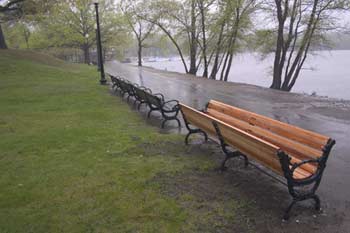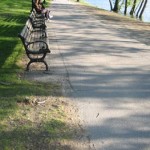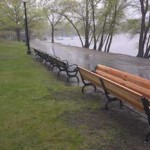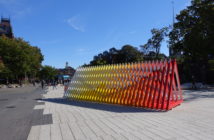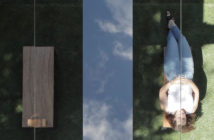Part I: Futility
A few weeks ago I received an email from an artist named Matthew Hincman. It was only a few short lines about a sculpture he had installed at the Jamaica Pond, and a picture. "The sculpture has begun to finally have an audience now that the rain has stopped long enough for people to get out and about. I hope you have the opportunity to see the work. It will be installed as long as it is can. This object was not sanctioned or reviewed by any city or art agency."
By the time I made my way to the Pond to see the work, it was gone. Were it not for this short email and the photo, I would have never known it existed. Yet, with the few clues provided by the photo I was able to find the spot once occupied by his work, which now showed only the narrow ruts in the dirt where it once sat.
The reason for the delay between his email and my walking up the street to the Pond, and probably also the filter through which I viewed those ruts, was a trip to some of the Civil War battlefields in Virginia, Maryland and Pennsylvania. While Gettysburg is full of monuments, places like Chancellorsville are mere paths in the woods with signs to ditches marked 'Confederate Trenches' and ruts in the dirt labeled 'Cannon Pits'. For me, there was something equivalent in the ruts I saw alongside the Jamaica Pond, and my knowledge that an artwork once sat there, that made me consider Hincman's project more seriously.
Strangely, when considering both the Civil War and Hincman's work, the same word comes to mind: futility. Hincman's sculpture (as presented in his photograph) is a variation on the park benches found beside the walking path near the pond. His bench, however, does not form the usual 'L' shape that is comfortable; instead it makes a 'U' shape that denies seating. As a site of relaxation and comfort, it is invalid and attempts to find respite would be futile. Further, sitting beside a heavily trafficked path in an area known for aggressive neighborhood policing, it was doomed to be removed rapidly. Hincman even hints at this in his email: It will be installed as long as it is can.
It should be noted that I have no knowledge that the piece was removed by the city or any other agency; the artist may have simply taken it back to his studio. The implication of his email was that removal would not be by his hand, and I'm inclined to believe it. The futility present in the piece, and the futility of the effort to install a work doomed to be removed by confused city workers, is what makes me love the art. I want it to be futile, to be doomed, to be nearly forgotten except by the handful of folks who passed it looking for a seat and were denied rest; for the 4am drunks who tried to sleep in it's curve; and for the park workers who would go home to tell their families of the weird thing they had to remove this afternoon.
Is futility a great subject for art? I think so. Matthew Hincman has created a piece that, while I never even saw it in person, has made me consider the value of public art and what it means to have an experience that causes one to consider the world differently. His useless park bench, and the ruts in the dirt left by its removal, both tell of a kind of world in which art, experience, frustration and surprise all matter.
Part II: Serendipity
The day after I wrote the above text about Hincman's piece, I received another email from him, much longer than the first. It began: "Yes, the sculpture is gone, and yes, the City took it, BUT..."
He went on to tell me that after installing the sculpture, he had attached contact information that kept being destroyed by the never-ending rain. After leaving town for a few days, he returned to find the piece missing, and contacted Commissioner of the Parks, "and just inquired about the piece." The result, after some phone-tag, was a message from Bernie Lynch, Director of Maintenance for the Boston City Parks.
"Hi Matthew, this is Bernie Lynch from the Parks Department. I appreciate you trying to get in touch with me, but we really need to talk. I have a lot of questions, and I need a lot of answers from you."
I was a bit worried at this, and called him immediately. His first question was,"How are you today?" and second question,"So, what is this? Some sort of guerilla art project?"
He told me I could not just go putting sculptures up without permission. Then he asked me about my intentions regarding the piece. I asked him to clarify. He said,"Well, do you want it to be re-installed?"
We then discussed whom I should go to (The Boston Art Commission & Sarah Hutt). He told me the piece was secure, and he was in no way put-out that he (his men) had to move the sculpture. He commented on the high craftsmanship of the bench, and asked me a little about the sculpture. When I described more my process of making the sculpture, he said although the piece was secure, he would make certain it was even more secure. He told me he had already shared with Sarah Hutt his opinion about the sculpture, and she was also in support of it.
This past Tuesday, June 13, I met and presented the project to the Boston Art Commission. They could not have been more supportive of the project. I am in the next week going to liaison with Bernie Lynch to re-install the sculpture ASAP. It should be there through JP Open Studios the first week of October.
Part III: Futility Denied?
One of the highlights of the tenure of Mayor Menino has been a consolidation of arts-related offices, and increased attention to things like public art and alternative spaces. One of the people in the center of this is Sarah Hutt, who is the Director of Visual Arts Programming and the Director of the Boston Art Commission in the Mayor's Office of Arts, Tourism & Special Events.
When I contacted her about Hincman's sculpture, she replied: "it was no problem, he just put it in and no one knew what it was. (W)e are all tremendously excited to have it reinstalled."
So, was Hincman's piece ultimately futile? It's design certainly denies visitors the basic function of a bench: seating. This denial could inspire questions about the objects we see everyday, and what to expect from them [1]. As Hincman put it: "When a viewer approache(s) an object with the understanding that it is a work of art, they carry with them preconceived notions about how they should begin to understand the object. But when an object can be approached purely as an object in the world, but somehow different, somehow charged, I think it can lead to a richer interpretation."
Was the placement of the object in a location where it was doomed to be removed futile? Based on the fact that it was removed we must conclude yes, or that the inherent futility that of the piece was realized when it was removed. Yet, the very hope that Hincman had for people to see his object as "somehow different" also caused the city to consider re-installing the piece, so that many more visitors to Jamaica Pond can question the function of his bench and develop their own "richer interpretation".
While I don't think it is a good idea for every artist in town to run out and hang their work or place their sculptures wherever they see fit, I do applaud Hincman for his subversive act that, ultimately, found it's way to the ideal audience and support system. His project, on one hand a simple sculpture about experience, has also proven that our city and it's administrators care deeply about artists and that great things can (and do) happen here.
----
[1] - A strange side note to this story concerns a blog by Steve Garfield called 'Off On A Tangent.' His recent project has been 'Park Bench Revisited', featuring musings on Hincman's piece. Part one and part two are online, and there may be more to follow.
"Jamaica Pond Bench" will be on view as soon as the city can get it re-installed through Jamaica Plain Open Studios, Saturday, September 30 & Sunday, October 1, 2006. It can be found on the walking path beside Jamaica Pond.
Top image courtesy of the artist.
Bottom image by the author.

